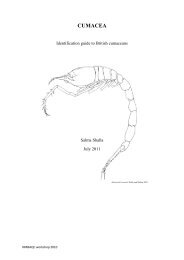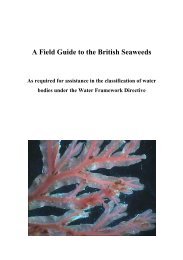Guide to identification of Lumbrineridae - NMBAQC
Guide to identification of Lumbrineridae - NMBAQC
Guide to identification of Lumbrineridae - NMBAQC
Create successful ePaper yourself
Turn your PDF publications into a flip-book with our unique Google optimized e-Paper software.
6<br />
Explanation <strong>of</strong> terms<br />
Acicula – supporting bristle embedded in the parapodium<br />
Attachment lamellae – additional pieces <strong>of</strong> the maxillary apparatus, usually situated lateral <strong>to</strong> or below<br />
the individual maxillae. Rod-shaped attachment lamellae situated lateral <strong>to</strong> mx I are by some authors<br />
referred <strong>to</strong> as “bridles”.<br />
Bidentate hook – hook with two strong distinctly separated teeth<br />
Branchial lobe – cylindrical <strong>to</strong> short digitiform process extending from the parapodium and equipped<br />
with capillary blood vessels for gas exchange. Present in some genera and species.<br />
Carrier – part <strong>of</strong> the maxillary apparatus situated posterior <strong>to</strong> the first maxillae (mx I) and connected<br />
<strong>to</strong> it by a ‘click-joint’<br />
Chaetiger – segment bearing chaetae<br />
Composite hooded hook – hook with a distinct subdistal joint separating the outer part (blade) from the<br />
shaft. Hood with a more or less distinct constriction at the position <strong>of</strong> the joint.<br />
Composite spiniger – simple gradually tapering chaeta provided with a joint<br />
Connecting ligament – additional piece placed between and connecting the bases <strong>of</strong> mx I and mx II.<br />
Also referred <strong>to</strong> as connecting lamella.<br />
Limbate chaeta – simple gradually tapering chaeta provided with a brim along most <strong>of</strong> the length,<br />
<strong>of</strong>ten gently curved. Found in anterior body <strong>of</strong> all species.<br />
Maxillae – paired and usually the most prominent elements <strong>of</strong> the maxillary apparatus. Maxillae are<br />
generally numbered from I <strong>to</strong> V from behind and forwards (different numbering systems may be found<br />
in older literature).<br />
Maxillary apparatus – dorsal part <strong>of</strong> the jaws consisting <strong>of</strong> several individual elements: four or five<br />
pairs <strong>of</strong> maxillae, carrier, connecting ligaments and attachment lamellae<br />
Maxillary teeth – well-defined projections on the maxillae directed inwards or upwards. In some<br />
genera knoblike projections or swellings may be found in addition <strong>to</strong> defined teeth, by some authors<br />
also referred <strong>to</strong> as teeth.<br />
Multidentate hooded hook – hook with a rounded apex with several small teeth encapsulated by a<br />
transparent hood. Only type <strong>of</strong> chaeta in posterior body <strong>of</strong> most species.<br />
Occipital antenna – small antenna placed posteriorly on the pros<strong>to</strong>mium; in lumbrinerids in the fold<br />
between pros<strong>to</strong>mium and peris<strong>to</strong>mium. May also be referred <strong>to</strong> as nuchal antenna or nuchal papilla.<br />
Pseudocomposite hooded hook – hook with an incomplete separation between the outer part (blade)<br />
and shaft. Usually with a constriction <strong>of</strong> the hood as in composite hooks.




